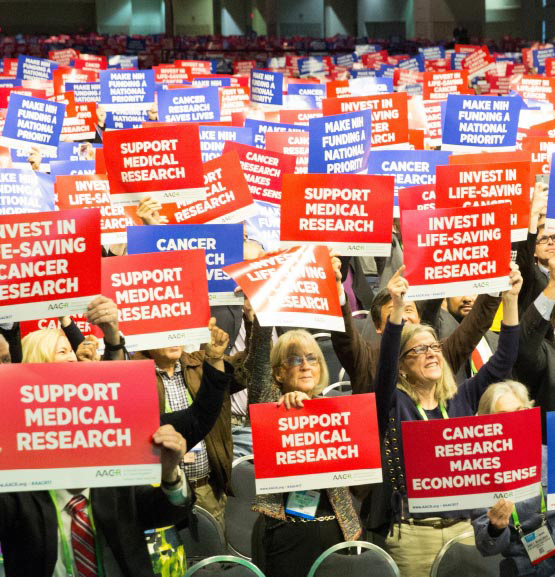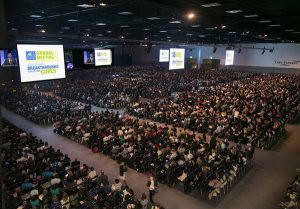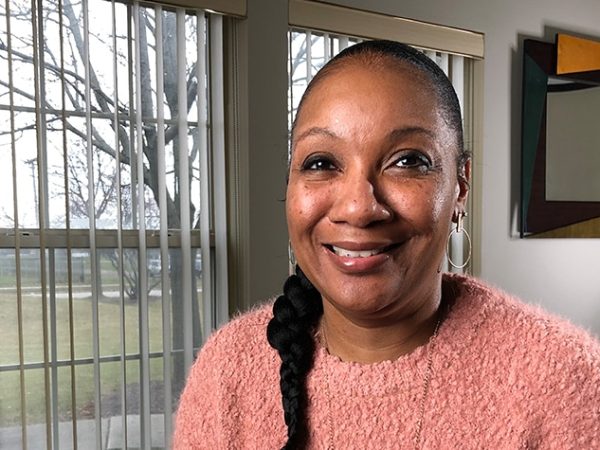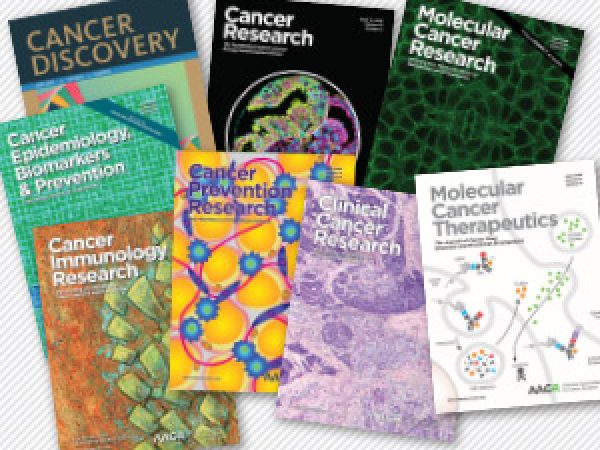Behind the Scenes at the Annual Meeting: Five Questions With the AACR’s Senior Director of Meetings
In just over a month, the Georgia World Congress Center in Atlanta will host the American Association for Cancer Research (AACR) Annual Meeting 2019. This signature event showcases the latest and most promising developments in cancer research, drawing scientists, clinicians, advocates, and policymakers from around the world.
A meeting of this size and scope requires months of intense planning. For the sixth consecutive year, Pamela Ballinger, senior director of Meetings and Exhibits, is at the helm of the Annual Meeting. In the past six years, the Annual Meeting has grown from approximately 17,000 attendees to 22,500, and has featured some thrilling developments, such as the advent of immunotherapy and the Cancer Moonshot initiative.
This year’s meeting, with a theme of “Integrative Cancer Science • Global Impact • Individualized Patient Care,” promises a wealth of opportunities to share information, make connections, and inspire all members of the cancer community. With a few weeks to go, we checked in with Ballinger to learn what goes on behind the scenes.
How long does it take to plan an Annual Meeting, and how many staffers work on it?
The planning for one Annual Meeting begins well before the previous one has finished. I would say the planning cycle for an Annual Meeting is about 18 to 24 months, although location is determined well before that. In fact, we’ve booked locations for the next 12 years!
A major reason we need to plan so far ahead is the tremendous size and popularity of the Annual Meeting. Now that attendance is up around 22,000 to 23,000, there aren’t that many venues that can accommodate us. So, we book well ahead to make sure we have a meeting location that is appealing, easy to reach, and able to handle the very large crowd.
We currently have 15 staffers in the AACR Meetings department, who plan the Annual Meeting in addition to numerous smaller conferences and workshops over the course of the year. As we speak, they’re working on laying out the exhibit space for Annual Meeting 2020, which will be in San Diego. The exhibit space for that meeting will be sold at this year’s meeting, so yes, plans are well underway.
What attributes does Atlanta have as a meeting location?
Atlanta is going to be a wonderful location! We haven’t held the Annual Meeting there in a long time, and I’m excited to be heading back there this year.
First of all, the city has really changed. There’s a little more of a foodie focus than there used to be, and some of the neighborhoods have developed into fun, interesting destinations. Not too far away from the convention center, there’s the Ponce City Market. It’s a former Sears & Roebuck building that’s been transformed into a big food hall with event space both inside and on the rooftop.
Solely from a logistical standpoint, Atlanta is a convenient place to have a meeting, with a great airport and a large convention center. In fact, we anticipate that we’ll be able to accommodate everybody for the plenary sessions, without the need for overflow rooms.
And as we increase our focus on cancer health disparities, Atlanta provides a wonderful backdrop thanks to its rich history of civil rights. It’s the birthplace of Martin Luther King, Jr., and there are numerous ways to explore and honor his legacy, including a visit to his boyhood home.
It’s a great city to explore—it’s just a question of fitting it all in around your meeting itinerary!
How has the Annual Meeting changed in the years you’ve been organizing it? Has the growth been gradual, or was there one specific catalyst that changed the size and scope?
The growth felt gradual for a while. But I would say the 2017 meeting in Washington, D.C., was a real turning point.
Washington was exciting because it enabled us to offer a lot of wonderful policy sessions, and the attendees were really passionate about those program offerings. And Vice President Joe Biden, who had addressed the Annual Meeting in 2016 in New Orleans, came back and delivered such a powerful address. He shared great, personal messages about maintaining the momentum behind cancer research.
However, some sessions were so popular that we experienced overflow crowds. That’s the motivation behind some of the innovative technology that you’ll see at this year’s meeting and in the future.
What are some elements of the Annual Meeting that an attendee might not think much about, but that require a lot of effort behind the scenes?
Technology is a major one! The presenters come in and anticipate that the sound will be perfect, the slides will go smoothly, and everything will go according to plan. I don’t think most people realize the hours it takes to make sure that will happen. Beginning with schematic drawings of each room, and ending with the final sound check, our staff and the folks we contract with at each site put in a lot of effort to ensure the logistics work and the presentations go off without a hitch.
And because technology is always changing, it has given us many ways to enhance the attendees’ experience. There’s an Annual Meeting app, which will be available around March 8, that lets you create a personal itinerary but also keep an eye on sessions and mini-symposia that you can’t personally get to.
Then, there are certain services we provide that might not be important to every attendee, but that are very important to those who need them. For example, we provide full-service child care through KiddieCorp., a major national provider with an outstanding reputation. They have excellent caretakers, activities, games, snacks, everything. It’s a very safe and nurturing environment. The AACR subsidizes the cost of this child care, and we’ve managed to keep the hourly rate the same for the past five years. Also, we have a nursing mothers’ suite open all day, every day, to provide privacy and comfort.
On another note, food and beverage planning requires a lot of effort that one might not notice, but it’s very important to the attendees. Over the years, dietary restrictions and requirements have escalated, and we work very hard to make sure that all needs are met while still meeting our budget.
Do you have a favorite moment from the Annual Meetings you’ve organized?
In 2017, after several years of robust funding for medical research, the political climate was changing, and the National Institutes of Health budget was being threatened. At the conclusion of the Opening Ceremony, more than 12,000 attendees stood up in unison and held up placards expressing the vital importance of continued funding. It was a quiet, but incredibly powerful, moment.

At the Opening Ceremony at the 2017 Annual Meeting, attendees raised placards proclaiming the need for continued funding for medical research. AACR file photo.





